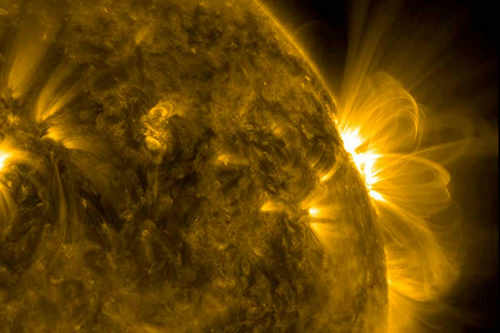
Goodness, gracious, great balls of fire (Credit:SDO/GSFC/NASA)
The sun is full of fireballs. Huge blobs of hot plasma have been spotted hurtling through the sun’s chromosphere - the area between its surface and its outer atmosphere - and they could help explain how the sun’s atmosphere gets so hot.
Shuhong Yang at the National Astronomical Observatories of the Chinese Academy of Sciences and his colleagues spotted what they called “chromospheric cannonballs” using the New Vacuum Solar Telescope in China, in a series of observations during 2017 and 2018.
On average, these plasma projectiles are about 1.5 billion cubic kilometres in size, which is slightly more volume than all of the water on Earth, and they have an average mass nearly 3 times as big as the Titanic. They also race across the sun at an average speed of 56 kilometres per second.
“If you were watching from near the sun, it would look like a huge, fast-moving ball-shaped monster flying along a curved trajectory,” says Yang. The trajectories appear to follow the sun’s magnetic field in an arc, like the path of a cannonball flying through the air. Yang and his team say that these scorching blobs may be propelled by a process called magnetic reconnection, in which parts of the sun’s magnetic field crack open and then snap back together, releasing a burst of energy that can toss plasma across the sun.
Marco Velli at the University of California, Los Angeles, says that it’s not yet clear whether chromospheric cannonballs can be attributed to magnetic reconnection. He says that if reconnection does cause cannonballs, observing them might be key to understanding one of the sun’s greatest mysteries: why the sun’s atmosphere, the corona, is so much hotter than its surface.
“If it is reconnection, it’s an important observation because reconnection is a very important phenomenon in the universe,” says Velli. Magnetic econnection occurs in all sorts of cosmic objects, from planets to supernovae. “It’s a really fundamental phenomenon that we haven’t understood in all its complexity yet.”(New Scientist)
Journal reference: The Astrophysical Journal Letters, DOI: 10.3847/2041-8213/ab2fe2

Address: 20A Datun Road, Chaoyang District, Beijing, China code: 100012
Tel: 010-64888708 E-mail: naoc@nao.cas.cn

